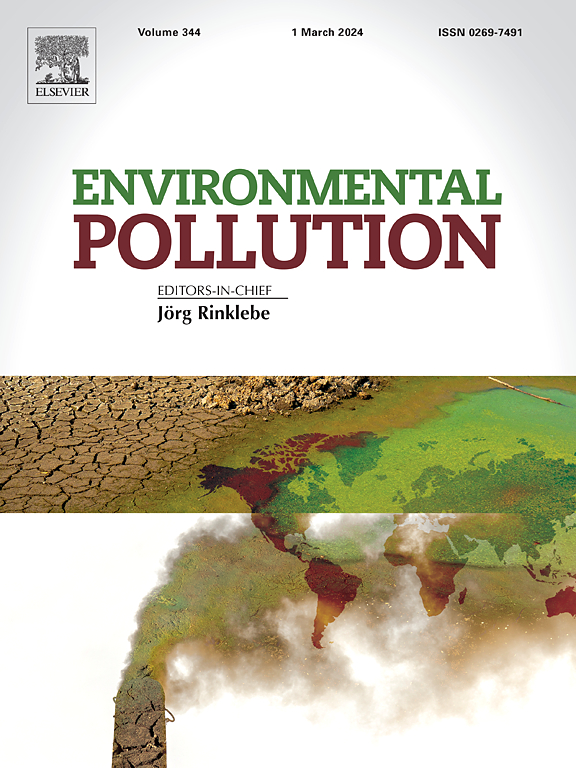Quantifying regional transport contributions to PM2.5-bound trace elements in a southeast coastal island of China: Insights from a machine learning approach
IF 7.6
2区 环境科学与生态学
Q1 ENVIRONMENTAL SCIENCES
引用次数: 0
Abstract
Identifying and quantifying pollution sources and their associated health risks are essential for formulating effective pollution control policies. This study analyzed PM2.5-bound trace elements based on one year of sampling data collected from a low-PM2.5 island in southeastern coastal China. A de-weathered model based on the eXtreme Gradient Boosting (XGBoost) algorithm was applied to remove meteorological influences and estimate local baseline pollutant concentrations. By combining backward air mass trajectories with de-weathered concentrations, we quantified the variation in transport contributions among different trajectory types. Results indicated that meteorological factors reduced PM2.5 and anthropogenic trace element concentrations by 36.7 %–58.4 % in summer, but increased them by 6.4 %–26.0 % in winter. In contrast, elements related to shipping emissions showed an opposite trend. Positive matrix factorization (PMF) identified industrial and shipping emissions as the two main sources of trace elements, originating from distinct regions. Shipping emissions contributed greatly health risks in summer, while industrial emissions dominated in other seasons. The non-carcinogenic risk (NCR) remained within acceptable levels, whereas carcinogenic risks (CR) exceeded recommended thresholds. Marine airflows (MA), inland airflows (IA), and local airflows (LA) altered trace element concentrations by −3.7 %, +6.4 %, and −5.4 %, respectively. These airflow types changed NCR by −16.4 %, +8.2 %, and −13.5 %, and CR by −4.1 %, +4.7 %, and −28.9 %, respectively. These findings underscore the substantial impact of regional transport on trace elements and the critical need for coordinated regional air quality management, offering new insights into pollutant sources and their associated health risks in relatively less polluted coastal regions.

量化中国东南沿海岛屿区域运输对pm2.5微量元素的贡献:来自机器学习方法的见解
确定和量化污染源及其相关的健康风险对于制定有效的污染控制政策至关重要。本研究基于从中国东南沿海一个低pm2.5岛屿收集的一年采样数据,分析了pm2.5束缚的微量元素。采用基于极端梯度增强(XGBoost)算法的去风化模型去除气象影响并估算当地基线污染物浓度。通过将反向气团轨迹与去风化浓度相结合,我们量化了不同轨迹类型之间输送贡献的变化。结果表明,气象因子在夏季使PM2.5和人为微量元素浓度降低36.7% ~ 58.4%,在冬季使其升高6.4% ~ 26.0%;相比之下,与航运排放有关的因素则呈现相反的趋势。正矩阵分解(PMF)确定工业和船舶排放是两个主要的微量元素来源,来自不同的地区。船舶排放在夏季对健康危害最大,而工业排放在其他季节占主导地位。非致癌风险(NCR)保持在可接受的水平,而致癌风险(CR)超过了建议的阈值。海洋气流(MA)、内陆气流(IA)和局地气流(LA)对微量元素浓度的影响分别为-3.7%、+6.4%和-5.4%。这些气流类型使NCR分别改变了-16.4%、+8.2%和-13.5%,CR分别改变了-4.1%、+4.7%和-28.9%。这些发现强调了区域运输对微量元素的重大影响以及协调区域空气质量管理的迫切需要,为污染相对较少的沿海地区的污染源及其相关健康风险提供了新的见解。
本文章由计算机程序翻译,如有差异,请以英文原文为准。
求助全文
约1分钟内获得全文
求助全文
来源期刊

Environmental Pollution
环境科学-环境科学
CiteScore
16.00
自引率
6.70%
发文量
2082
审稿时长
2.9 months
期刊介绍:
Environmental Pollution is an international peer-reviewed journal that publishes high-quality research papers and review articles covering all aspects of environmental pollution and its impacts on ecosystems and human health.
Subject areas include, but are not limited to:
• Sources and occurrences of pollutants that are clearly defined and measured in environmental compartments, food and food-related items, and human bodies;
• Interlinks between contaminant exposure and biological, ecological, and human health effects, including those of climate change;
• Contaminants of emerging concerns (including but not limited to antibiotic resistant microorganisms or genes, microplastics/nanoplastics, electronic wastes, light, and noise) and/or their biological, ecological, or human health effects;
• Laboratory and field studies on the remediation/mitigation of environmental pollution via new techniques and with clear links to biological, ecological, or human health effects;
• Modeling of pollution processes, patterns, or trends that is of clear environmental and/or human health interest;
• New techniques that measure and examine environmental occurrences, transport, behavior, and effects of pollutants within the environment or the laboratory, provided that they can be clearly used to address problems within regional or global environmental compartments.
 求助内容:
求助内容: 应助结果提醒方式:
应助结果提醒方式:


